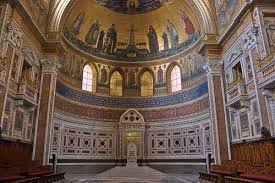The dedication of the basilica of St. John Lateran (San Giovanni in Laterano) 9th November.
Readings: Ezekiel47:1-2,8-9,12; Psalm 46 2-3,5-6,8-9; I Corinthians3.9c-11-16, 17; John 2.13-23.
This basilica is still the official residence of the bishop of Rome, even though he lives in the Vatican state and his cathedra is in the apse. This feast became a universal celebration in honour of the basilica called "the mother and mistress of all churches of Rome and the world" (omnium urbis et orbis ecclesiarum mater et caput).
In the fourth century after Constantine had his vision of the cross before the Milvian Bridge battle that he won in 312, he became a sympathiser of those following Christ who had been persecuted by previous emperors. That was about to change. In 313 A.D. Constantine issued the Edict of Milan that legalised Christianity. He himself never became a Christian until his death bed. However, his mother, Helena was a Christian.
In 313 Constantine gave to the bishop of Rome, Miltiades, the palace and land of the Laterani family, a gift brought to the emperor by his second wife, Fausta. Afterwards the basilica was built and consecrated by bishop Sylvester in 324 to Christ the Saviour. In the tenth century it was dedicated also to John the Baptist and in the twelfth to John the Evangelist as well. At the time of its consecration the basilica was actually outside the city of Rome that was still controlled by the Senate.
Ever since 324 until the Avignon schism in the 14th century, Lateran was the bishop of Rome’s residence. Over the years, the basilica and residence faced sacking by Alaric in 408 and a century later by Genseric after which it was rebuilt by Leo the Great. At the end of the ninth century, it was destroyed by an earthquake and rebuilt by Sergius III. In the 14th century it was extensively damaged by fire. Despite all this, the Lateran hosted five ecumenical councils.
When the schism finally ended, the basilica and palace were in such disrepair, it was deemed unlivable and the bishop of Rome decided to live elsewhere in what eventually became the Vatican state.
Every Holy Thursday the Liturgy of this day, including the washing of the feet, is celebrated in this basilica known today as St. John Lateran.
In the readings for this day, the first is from Ezekiel, one of the loveliest passages from this book. It is a vision of the water flowing from the various corners of the temple. As this water flowed from the holy of holies, it sustained all kinds of life. It is the water of life as later was seen in baptism.
Paul’s letter to the Corinthians speaks of each Christian’s body as the temple of God. How can this be? Within each person the Spirit of God lives. It is this Spirit that gives life and eventually takes it away. If we understood that we are the temple of God then I am sure we would not be tempted to abuse it through drugs, excessive alcohol, wrong use of sex, uncleanliness and indeed any kind of neglect.
The reading from the Johannine Gospel is technically Jesus cleansing the temple of abuse but in reality, He is really saying from now onwards He is the temple, a temple that will be destroyed but in three days will be restored. Jesus is of course referring to His death and then His resurrection. In that all who believe will have life that will not end.
